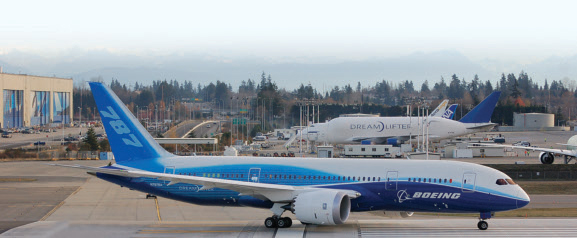|
The interior includes 135 seats, multiple
lavatories and two crew rests. Certifying
the interior components involves analyses
and testing of the lighting, lavatories,
stowage bins, dimmable windows and
galleys.
Configured for flight-testing purposes,
the interior of this aircraft includes
instrumentation racks, flight-test equipment
and workstations for engineers.
“This airplane is specifically configured
to test the passenger experience elements
of the airplane,” said Tom Galantowicz,
director of 787 Interiors, Commercial
Airplanes. “Our engineers and flight-test
team use a disciplined process to certify
the various elements of the interior and
conduct airplane-level verifications.”
“Our team is making great progress
and is looking forward to getting this
airplane in the air later this month,”
Galantowicz added. Flight testing will
continue in the months ahead. Delivery
of the first 787 to launch customer ANA
(All Nippon Airways) of Japan is planned
for the fourth quarter of this year.
According to Boeing, since the first
flight in mid-December, the test program
has conducted 15 flights and achieved
several important accomplishments. The
test airplane has reached an altitude
of 30,000 feet and a speed of Mach
0.65 (close to 400 nautical miles per
hour) with nearly 60 hours of flying time
completed. During these flights, initial
stall tests and other dynamic maneuvers
have been run together with an extensive
check of the airplane’s systems.
So far, six different pilots have been
behind the controls of the 787. Scott
Fancher, vice president and general
manager of the 787 program, said test
results have met all the expectations and
have matched the pilots’ experience in
simulations they have run.
In the weeks ahead, the team will
continue to expand the flight envelope
and bring the 787 to an altitude of more
than 40,000 feet and a speed of Mach
0.85 (about 420 nautical miles per
hour). Subsequent testing will push the
airplane beyond expected operational
conditions.

The revolutionary composite materials
used to build Boeing’s Dreamliner 787
passenger jet look set to transform the civil
aviation industry forever, say officials. The
lighter weight of the aircraft’s component
materials allow the Dreamliner to make
massive savings on fuel – around 20%
less than similar-sized planes.
Boeing officials are confident that
the composite plastics that make up
around 50% of the plane are twice
as strong as conventional materials,
lighter than aluminium and offer greater
resistance to fire. The state-of-the-art
carbon fibre composites are being used
in the fuselage of this new commercial
passenger jet.
All eyes are on Seattle, waiting to
see the aircraft rolling for its maiden
commercial flight.
Will some Indian airlines follow the
Japanese way, is actually the million
dollar question. But it is to happen,
perhaps sooner than later.
Meanwhile, Boeing and United Airlines
have finalized an order for 25 787-8
jetliners. The agreement includes the
opportunity to purchase another 50
Dreamliners.
“Boeing and United Airlines share
an 80-year partnership,” said Jim
Albaugh, president and CEO of Boeing
Commercial Airplanes. “United, which
launched the Boeing 777, now begins
a new chapter with the 787 Dreamliner,
the most technologically advanced
commercial jetliner ever built.”
The order is valued at $4.2 billion at
average list prices.
|